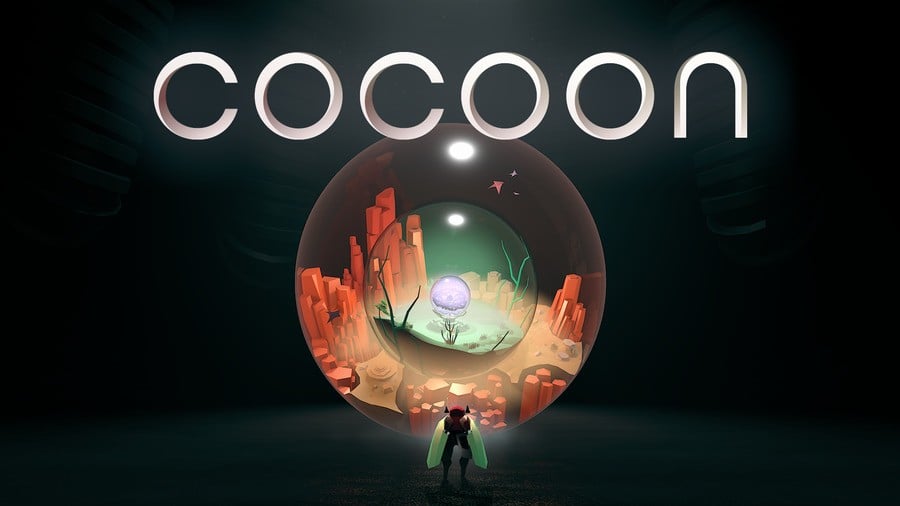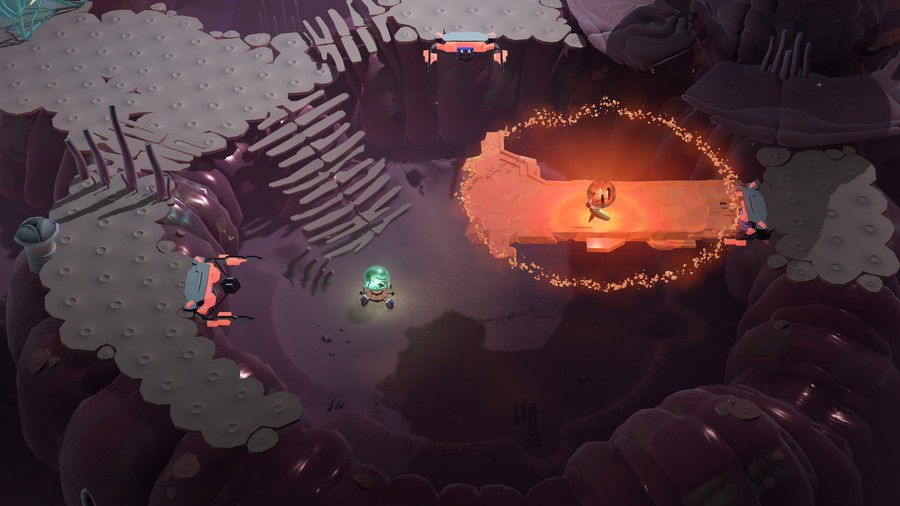
Off the back of its PS5, PS4 release date announcement during the Annapurna Interactive Showcase, we caught up with Cocoon developer Geometric Interactive to learn more about what is one of our most anticipated indie titles of the year. With the ability to carry entire worlds on your back and dive into them to solve puzzles, it's an amazing concept that has us yearning to play the full release. To soothe the wait a little, we quizzed Jeppe Carlsen (game director), Erwin Kho (art director), and Jakob Schmid (audio director) on all things Cocoon.
Push Square: When you announce a game and mention team members that have worked on Playdead titles, what sort of expectations do you believe that sets for the player? What themes, gameplay mechanics, and story aspects do you at that point think you have to deliver on?
Jeppe Carlsen: At Geometric Interactive, we simply focus on making the best game possible. COCOON is a very original game and we hope players will be positively surprised when the game defies their expectations.
Having left Playdead, how long did it take for you to land on Cocoon? Did you have many other game concepts floating about?
Jeppe Carlsen: I started working on COCOON relatively shortly after I left Playdead, and the game has now been in full-time development for more than 6.5 years. I usually have a few different game concepts floating about, but COCOON felt special, and I tend to get quite focused (borderline obsessive) once I start working on a game.
Are there any ideas or philosophies from Limbo and Inside you're carrying over into Cocoon?
Jeppe Carlsen: During my 8 years at Playdead, I refined my puzzle-designing skills a lot. My instincts about what works and what doesn't are pretty good, and so is my ability to anticipate how players approach the obstacles I create. It is this experience I bring with me to COCOON — a game where fun gameplay and interesting puzzles is always our number one priority.

Jumping between worlds and manipulating their layers to solve puzzles is a core mechanic in the game, but how many worlds deep can you go?
Jeppe Carlsen: We introduce and expand on concepts very gently, and never overwhelm the player with too many orb worlds available at the same time. You’ll have to play the game to find out exactly how deep it goes.
Having played the demo at Summer Game Fest, it struck me how simple the controls were in contrast to what could potentially be a complex mechanic in world jumping. It felt easy to pick up and play. Was this a conscious decision to keep the controls easy to learn and master?
Jeppe Carlsen: Exploration and puzzles in a hierarchy of worlds within worlds is inherently somewhat complex, and I wanted to counter that complexity by making the game very accessible. In fact, COCOON is controlled entirely using only the left stick and one button. I am proud of how many unique gameplay mechanics we have managed to fit into this simple control scheme, and how the simplicity makes players forget about the controller immediately, so they can immerse themselves in our worlds and focus on the challenges.
Are there any particularly complex mechanics or puzzles you had to cut?
Jeppe Carlsen: Cutting content is a part of the process of making great games, and COCOON is no exception. One example that comes to mind was a “transporter” — a large creature that you could climb and then take control over. You had to dock this creature at different “puzzle islands” and gather components that could slot into the transporter to eventually make it fly. It was a cool concept, and unfortunately we got really far with art, animations, everything, before I realized that the pacing in this section was simply off. Part of what makes COCOON flow nicely is that you never stay in one world for too long, and I had not planned this section out well enough, so it had to go. It always hurts to cut content, especially when other team members have worked on that content for a long time.
Overall, I would say however, that we managed to get everything into COCOON that I hoped we would. This includes some ideas that have an almost paradoxical nature, which were part of my own early fascination with this game concept.

What's the thinking behind including boss battles? Do you wish to give the player a break from puzzles or do you have other ideas for them?
Jeppe Carlsen: The boss battles are great for pacing, but they also serve an important role in the narrative.
Can you speak to the striking visual art style and audio design of Cocoon? How do you go about creating a look and sound such as this?
Erwin Kho: In terms of the minimalist style, it's very much an evolution of the stylized low-polygonal work I did for my illustrations (I worked as a freelance illustrator for almost a decade before starting work on COCOON) and the influences of my graphic design background. It’s about geometry and color and an exploration of how you can create compelling visuals with such a restricted visual toolkit. It also allows you to bring contrast to certain elements in very satisfying ways; for example, to convey the biomechanical technology we use a lot of straight lines and hard edges but then we add certain elements or areas that have more curved edges and soft smooth shapes. These opposites amplify and add to one another.
In terms of design the game draws lots of inspiration from brutalist and art deco architecture. I love how monumental those buildings can appear. There’s an aging melancholy to them that I thought was a good fit for the lore of the game. And then there’s many biological shapes inspired by arthropods like praying mantis, lobsters, spiders, and marine life like jellyfish and starfish. Sea urchin shells in particular were very inspiring; they have these patterned bumps arranged on them that are very organized but not too perfect, which is how we tried to approach all of the biomechanical designs in the game. On top of all this there's the beautiful lighting and atmosphere rendering that our render programmer Mikkel Svendsen was responsible for. He made the game look like my concept renders from Cinema 4D, but then much better.

Jakob Schmid: In the beginning, when we were just 3 people working on COCOON, I decided on a general rule for all sound and music in the game: all sounds must be synthesized, no recorded sounds of any kind may be used. I got the idea when I was watching through the original Dragon Ball series from the 1980s, and noticed that most of the sound effects were quite obviously made on synthesizers. This rule would both play to my own strengths and fit the artificial but organic style of Erwin's artwork. Our sound designers Julian Lentz and Mikkel Anttila did an amazing job of upholding this rule and went far beyond what I could have imagined. Additionally, the music playing in most of the game is generated in real-time with a set of software synthesizers that I developed for COCOON.
Is there anything else you'd like to share about Cocoon?
Jeppe Carlsen: It has been a challenging game to design because of how all the different orb worlds are interconnected and we hope players will recognize the efforts we have put into making everything feel natural, intuitive and fun.
We would like to thank Jeppe Carlsen, Erwin Kho, and Jakob Schmid for taking the time to answer our questions, and Jackie Barraza for making the interview possible. Cocoon launches for PS5 and PS4 on 29th September 2023. Are you fascinated by the game's concept and puzzle-solving mechanics? Place a world on your back in the comments below.





Comments 2
Strangely the first thing I thought when I saw the title was. As long as it has nothing to do with Cocoon the movie. As that was such an awful film when I was young
I cannot wait for this game. The gameplay looks incredible.
Show Comments
Leave A Comment
Hold on there, you need to login to post a comment...